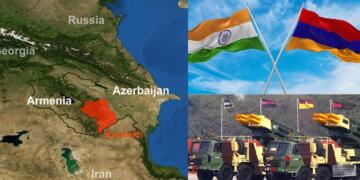India has made unprecedented development in its missiles program with an independent US Congressional report revealing that India is amongst the select few countries developing hypersonic weapons.
India and Russia collaborate on a hypersonic missiles programme:
As per the independent Congressional Research Service (CRS), India has collaborated with Russia on its hypersonic weapons programme. The Indo-Russian hypersonic missile program is called BrahMos II, which is a Mach 7 hypersonic cruise missile.
The CRS report added, “Although BrahMos II was initially intended to be fielded in 2017, news reports indicate that the programme faced significant delays and is now scheduled to achieve initial operational capability between 2025 and 2028. Reportedly, India is also developing an indigenous, dual-capable hypersonic cruise missile as part of its Hypersonic Technology Demonstrator Vehicle programme and successfully tested a Mach 6 scramjet in June 2019 and September 2020.”
India looking to take on the China threat:
With the development of new hypersonic weapons, India is looking to keep China in check. There are reports that China is expanding its missiles program.
Recently, a Financial Times story claimed that China had secretly tested a powerful new kind of hypersonic missile. It was reported that the China Academy of Launch Vehicle Technology announced its 77th rocket launch in July and the 79th in August. So, what about the 78th launch? Well, it is believed to be weapons system testing.
Jeffrey Lewis, a professor at the Middlebury Institute of International Studies at Monterey, explained, “The simplest way to imagine this new weapon system is to imagine the space shuttle, put a nuclear weapon in the cargo bay and then don’t bother with the landing gear.” The hypersonic weapon system briefly enters the orbit “and it glides back to Earth just like the space shuttle, except for when it gets where it’s going, it goes boom.”
China, on the other hand, denies that it tested a hypersonic weapon system. The Chinese Foreign Ministry described it as an experimental spacecraft, not a weapon. Anyhow, China has been investing massively in shorter-range hypersonic missiles, which poses a threat to India and other Chinese enemies in the Indo-Pacific.
In July, China was reported to be building over 100 silos to hold Intercontinental Ballistic Missiles (ICBMs) in its Northwestern city of Yumen on the edge of the Gobi Desert. China already has a stockpile of 250 to 300 nuclear warheads and the building of new silos signals a major expansion of the Chinese nuclear programme.
India, on its part, understands its tense relations with China. The two countries have a history of conflict. They went to a war in 1962, which China won and five years later, India and China fought a huge battle at Sikkim’s Nathu La, which India won. Over the past six decades, the Sino-India relationship has been very tense.
For more than one and a half years, the two countries have been locked in a standoff in Eastern Ladakh at the de facto Indo-Tibet border. Given the volatile relationship, New Delhi must ensure that there is no gap in the development of hypersonic weapons between India and China.
India’s hypersonic weapons good news for the world:
The US is highly concerned about the Chinese hypersonic weapons system. The issue of denials and speculations in China’s case means that Beijing may or may not be developing new weapon systems, but it can always intimidate the United States.
The US itself hasn’t made any rapid advances in the hypersonic missiles race. In February 2018, Admiral Harry Harris, former Commander of United States Indo-Pacific Command, said that the US was “falling behind” China’s hypersonic development. A recent US military hypersonic test too failed, which was described as a setback to the US in its hypersonic weapons race with China.
Therefore, the US will not mind its ally India developing a few hypersonic missiles to keep China in check though it will be somewhat sceptical given the very few countries successfully developing the next-gen weapons. Ultimately, India’s hypersonic missiles program is good news for the world. It allows the free world to stop China from getting too far ahead in the hypersonic missile development race.
China, on the other hand, must be very scared of its neighbour’s new missiles which erode whatever advantage Beijing wanted to get on the battlefield.


































